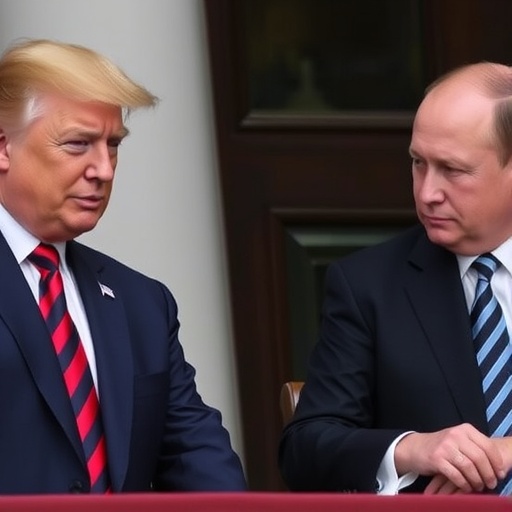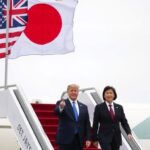Trump Cancels Putin Summit in Dramatic Move: No Meeting Until Ukraine Peace Deal is Secured, New Sanctions Hit Russian Oil
In a stunning escalation of U.S. pressure on Russia, President Donald Trump has abruptly canceled a highly anticipated summit with Vladimir Putin in Budapest, declaring that no face-to-face meeting will occur until a concrete peace deal for Ukraine is firmly in place. The decision, announced late Thursday from the White House, comes amid ongoing tensions in Eastern Europe and marks a significant hardening of Trump‘s stance on the Ukraine conflict. To underscore the seriousness of his position, the Trump administration simultaneously unveiled a fresh round of sanctions targeting Russia’s major oil companies, aimed at crippling Moscow’s war funding capabilities.
The move has sent shockwaves through international diplomacy circles, with analysts suggesting it could prolong the Ukraine stalemate while boosting U.S. leverage in negotiations. Trump’s statement, delivered during a press briefing, emphasized that “peace in Ukraine isn’t optional—it’s non-negotiable,” highlighting his frustration with what he called Putin’s “unyielding aggression.” This development not only derails months of planning for the summit but also signals a potential shift in U.S.-Russia relations under Trump’s second term.
Background on the planned Budapest meeting reveals it was intended as a venue for direct talks on Ukraine and broader global issues, including energy markets and NATO expansion. However, sources close to the administration indicate that recent intelligence reports showing Russian troop buildups near Ukraine’s borders prompted the cancellation. “We’re not rewarding intransigence with handshakes,” a senior White House official told reporters, speaking on condition of anonymity.
Trump’s Ultimatum: Peace in Ukraine Before Any Putin Handshake
President Trump’s decision to cancel the summit stems from a deep-seated commitment to resolving the Ukraine crisis on terms favorable to Kyiv and its Western allies. In his address, Trump explicitly linked the meeting’s fate to progress on a peace deal, stating, “I won’t sit down with Putin until there’s a real path to ending the suffering in Ukraine. No deal, no summit.” This rhetoric echoes Trump’s earlier criticisms of Russia’s 2014 annexation of Crimea and subsequent support for separatists in Donbas, where over 14,000 lives have been lost since the conflict began.
Experts point to the Minsk Agreements—brokered in 2014 and 2015—as a framework that has largely failed, with ongoing ceasefire violations reported by the Organization for Security and Co-operation in Europe (OSCE). Recent data from the OSCE indicates more than 1,200 ceasefire breaches in the past month alone, fueling Trump’s impatience. “Trump is using this as leverage to force Russia’s hand,” said Fiona Hill, a former National Security Council official and Russia expert at the Brookings Institution. “By tying the summit to Ukraine, he’s making it clear that Putin can’t have normalized relations without concessions.”
The U.S. position aligns with broader NATO efforts to support Ukraine, including $2.5 billion in military aid approved by Congress last year. Trump’s administration has ramped up diplomatic isolation of Russia, coordinating with European allies to enforce existing sanctions while preparing for escalation. Insiders reveal that Trump personally vetoed the summit after a classified briefing on Russian cyber activities targeting Ukrainian infrastructure, further eroding trust.
This ultimatum isn’t without risks. Critics, including some Republican senators, worry it could provoke Putin into more aggressive actions, such as increased energy exports to China to offset sanctions. Nonetheless, Trump’s base views the move as a strong show of American leadership, with polls from Pew Research showing 62% of Americans supporting tougher stances on Russia.
Behind the Scenes: Why the Budapest Summit Fell Apart
The canceled Budapest summit was envisioned as a landmark event, hosted in Hungary’s neutral capital to facilitate dialogue between Trump and Putin. Planning had been underway for weeks, with agendas covering Ukraine, arms control, and Arctic resource disputes. Hungarian Prime Minister Viktor Orbán, a known Putin ally, was set to mediate, adding a layer of intrigue to the proceedings.
However, fractures emerged during preparatory talks. U.S. diplomats reported that Russian negotiators refused to discuss Ukraine withdrawal timelines, insisting on recognition of Crimea’s status—a non-starter for Washington. “The Russians came to the table with demands, not solutions,” said State Department spokesperson Ned Price in a follow-up statement. Leaked cables, obtained by The New York Times, suggest Putin viewed the summit as an opportunity to ease sanctions pressure, but Trump’s team saw it as a chance to extract commitments.
Geopolitically, Budapest’s selection was symbolic; Hungary has navigated a delicate balance between EU membership and Russian energy ties. Orbán expressed disappointment, tweeting, “A missed opportunity for peace in Europe.” Yet, the cancellation avoids a potentially embarrassing photo-op for Trump if Ukraine talks stalled publicly.
Historical context underscores the summit’s fragility. Trump’s first term saw mixed U.S.-Russia engagements, from the 2018 Helsinki summit—criticized for appearing too conciliatory—to the 2020 arms control extensions. This latest snub recalls the 1980s Reagan-era boycotts, when ideological divides halted high-level meetings. With Ukraine’s war now in its eighth year, the stakes have never been higher, as European gas prices hover at record levels partly due to Russian supply manipulations.
Domestic politics also played a role. Facing midterm pressures, Trump aims to project strength on foreign policy, distancing himself from perceptions of being soft on Putin—a narrative pushed by opponents during his 2024 campaign.
New Sanctions Target Russia’s Oil Lifeline Amid Ukraine Tensions
In tandem with the summit cancellation, the Trump administration rolled out sweeping sanctions on Russia’s major oil companies, including Rosneft, Gazprom Neft, and Lukoil. These measures, enacted via executive order, prohibit U.S. firms from engaging in transactions with these entities and freeze related assets in American jurisdictions. The Treasury Department estimates the sanctions could strip Russia of up to $10 billion in annual revenue, hitting the sector that accounts for 40% of Moscow’s federal budget.
“These sanctions are a direct response to Russia’s destabilizing actions in Ukraine,” Treasury Secretary Janet Yellen declared. The package builds on previous rounds, which have already reduced Russia’s oil exports to Europe by 25% since 2022, according to data from the International Energy Agency (IEA). Specific prohibitions include bans on technology transfers for oil exploration, targeting Russia’s Arctic drilling ambitions.
Russia’s economy, already strained by the Ukraine conflict, faces compounded challenges. The ruble has depreciated 15% against the dollar this year, and inflation stands at 8.5%, per Russian Central Bank figures. Oil sanctions exacerbate this, as Putin has relied on discounted sales to India and China to maintain revenues—exports to Asia rose 50% last quarter, per OPEC reports.
Industry analysts warn of global ripple effects. “Higher sanctions mean pricier oil worldwide,” noted Ellen Wald, president of the Transversal Consulting energy firm. Brent crude prices surged 3% following the announcement, reaching $85 per barrel. U.S. allies like the UK and Germany have signaled support, with the EU considering parallel measures to phase out Russian imports by 2027.
Within Russia, the sanctions have sparked backlash. Putin addressed the nation, calling them “economic terrorism” and vowing retaliation, possibly through cyberattacks or fertilizer export curbs—affecting U.S. agriculture. Despite this, compliance from multinational firms like ExxonMobil has been swift, with several halting joint ventures in Siberia.
Global Echoes: Allies and Adversaries React to Trump’s Bold Pivot
The international community has responded with a mix of praise and caution to Trump’s cancellation and sanctions. Ukrainian President Volodymyr Zelenskyy hailed the move as “a vital stand for sovereignty,” pledging closer U.S. ties during a virtual call with Trump. In Kyiv, streets filled with demonstrations supporting the decision, with banners reading “No Peace Without Justice.” Ukraine’s economy, battered by war, relies heavily on Western aid; the U.S. has provided $61 billion since 2014, per the Congressional Research Service.
NATO Secretary General Jens Stoltenberg echoed Zelenskyy’s sentiments, stating, “This reinforces our collective defense against Russian aggression.” Yet, not all allies are unified. Hungary’s Orbán criticized the U.S. for “escalating tensions,” while Turkey—another NATO member with Russian S-400 ties—urged de-escalation.
On the adversarial side, China has positioned itself as a mediator, with Foreign Minister Wang Yi offering to host Ukraine talks in Beijing. Beijing’s state media accused Trump of “hegemonism,” aligning with Russia’s narrative. Iran’s response was muted, but its oil alliances with Moscow could deepen under sanction pressures.
European markets reacted sharply: The DAX index dipped 1.2% on energy sector fears, while safe-haven assets like gold rose 2%. Polling from YouGov shows 55% of Europeans back tougher sanctions, though energy-dependent nations like Germany express concerns over winter gas shortages.
U.S. domestic reactions vary. Democrats like Senate Majority Leader Chuck Schumer praised the sanctions but questioned the summit’s abrupt end, calling for congressional oversight. Republicans, led by House Speaker Mike Johnson, lauded Trump’s “decisive action,” tying it to border security analogies in campaign rhetoric.
Path Forward: Navigating U.S.-Russia Standoff and Ukraine’s Future
Looking ahead, Trump’s cancellation and sanctions set the stage for a prolonged U.S.-Russia standoff, with implications rippling across global security and energy markets. Diplomatic channels remain open through lower-level envoys, but experts predict no high-level Putin-Trump meeting before mid-2025 without Ukraine breakthroughs.
Ukraine’s path to peace involves multilateral efforts, potentially reviving the Normandy Format with France and Germany. Aid packages could expand, with Trump eyeing $5 billion more in defensive weapons. For Russia, sanctions may accelerate de-dollarization, pushing toward a BRICS-led financial system—though economists doubt its short-term efficacy.
Broader U.S. strategy under Trump emphasizes deterrence, including bolstering NATO’s eastern flank with 10,000 additional troops. Analysts like Michael Kofman from the Carnegie Endowment foresee intensified hybrid warfare from Russia, such as disinformation campaigns targeting U.S. elections.
Ultimately, the Ukraine conflict’s resolution hinges on sustained Western unity. As Trump prepares for G7 discussions, the world watches whether his hardline approach yields concessions from Putin or entrenches divisions. With stakes involving millions of lives and trillions in economic value, the coming months promise high drama in international relations.








